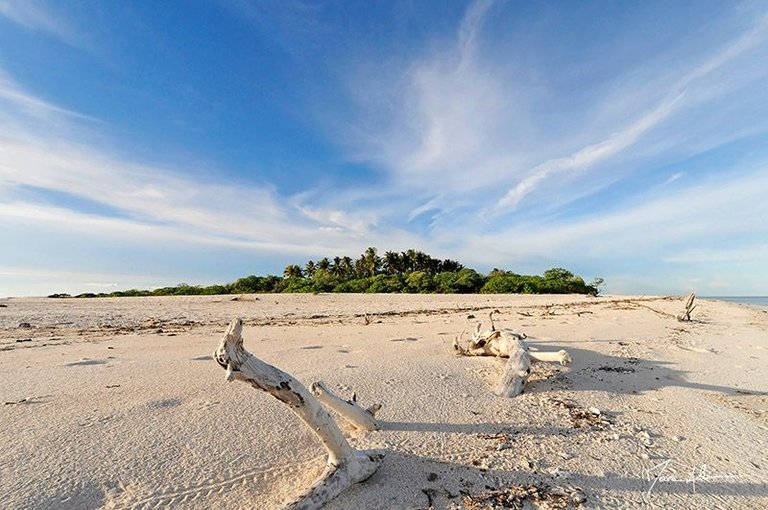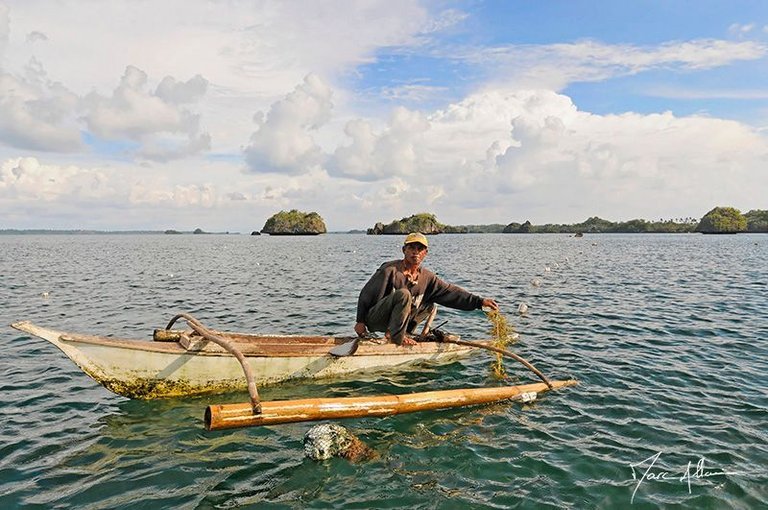As my primary language is not English, there are probably some mistakes in my translation.
Remember that the person who speaks here is NOT me, Vincent Celier (@vcelier), but Marc Allaria (@marc-allaria), a French guy.
THE CAGAYAN ISLANDS
* * * * *
THE TIME OF AN ILLEGAL FISHING ...
To watch it mimic the stars in a perfect reflection of the starry sky, it would be hard to believe that the sea of Sulu can sometimes chop this parody in a tear of wind and waves. These moments are all the more magical as they are unique. Nonchalance then takes over, meditation is omnipresent, and it is quite naturally that, inspired by this latent idleness, we finally discover the source ... This source is one of the last isolated pearls of the Philippines, The Cagayan Islands.

Mother fishing ship in the Philippines ...
 Boombong Islet
Boombong IsletAn atoll far from the overworked reality of the country. A bubble of isolation that makes us forget the 90 million Filipinos who, a few hundred kilometers from here, are busy with their activities on a rhythm typical of Asia. No, here, none of that, the calm is back, it seems never to be gone. As usual, it is the canoe fishermen who will send the first signs of hospitality to the stranger from the sea. Some will even share a few minutes of sailing alongside, and offer a share of from their fishing as a welcome. The atoll is large, its northern part remains submerged except for a small island where fishermen gone for several days get together to repair their lines, shelter or recover before going fishing for the night. Boombong islet is a pearl of vegetation surrounded by a ribbon of white sand. Diuni is one of those fishermen that I met there; he has left his village for several days to go fishing at sea on his 6m canoe. It is through him that the answer to the mystery of these strange concrete pilings built on the reef is elucidated. "These are constructions for the guardian," he says. A fishing guard here? Perched on a terrace in piles over the reef ?! "Yes, he is monitoring illegal fishing". Dynamite fishing and cyanide fishing (Siyanaï in the local language) were indeed common practice just a few years ago. A dive on the wall of the coral reef will confirm very quickly Diuni's comments. A coral cemetery, avalanches of limestone skeleton debris, and the work of Nature with a light moss covering the whole. The scenery suddenly becomes a lot less heavenly. "The fishermen were coming here from
Iloilo City (a main town 300 km away) to fish illegally; now it's under surveillance and they cannot do it anymore." The explanation is simple and well known in many places on the planet. To export more fish to countries in North Asia that have run out of stock for many years, fishermen used dynamite or cyanide and sent the product to Taiwan, Japan, or China. Now, it is the local fishermen who have recovered the sector, but more regularly this time. Once a month, a freighter comes to buy the fish from the island fishermen, brings it back to Iloilo where it will be packaged before being exported.
* * * * *
A HAVEN OF PEACE AND BEAUTY ...
 Seaweed fisherman
Seaweed fishermanThe interior of this ancient 19th century pirate landmark is not accessible by every ship. The shoals and the tortuous passage make access difficult. But the reward is beautiful for those who manage to lead their boat in the heart of the atoll. Several rocky fungi remind me of the morphology of Upi Bay in New Caledonia. The coasts are made aggressive and wild by rocks as if cut with knives, between which is hidden the sweetness of many idyllic beaches. The west of the atoll is without a doubt the most spectacular. A small labyrinth is drawn between several islets, the water is perfectly smooth and the beaches are sumptuous. It is here that Rodolpo cultivates seaweed. The cultivation of this seaweed is widespread in this part of Asia. Some cuttings tied around ropes and left about 6 weeks immersed will soon give big bouquets. These algae will then be dried before being shipped in the monthly cargo ship that will deliver it to Chinese mouths, but also to professionals in the pharmaceutical and food industries. The "pasty" aspect of your toothpastes, the creaminess of your yogurts, is the seaweed! In villages, English is hardly spoken, but the welcome is warm. A group of children is escorting me for a visit through the sand streets of the hamlet, a carpenter explains his technique in front of the frame of his next realization, the fishermen return, expected by their children, daily life is simple and seems happy.
PATIENCE AND HOPE ...
Saddened by the distressing sight of these first dives in the east of the atoll, I repeat the experience in the West this time. Closer to the villages, I hope that the illegal fishing activists could not crack so easily in front of the houses as out of reach in the north of the reef. My theory is quickly verified. Here, the break of the flat is much more pronounced. The drop-off quickly goes vertically up to 100m depth. Hard corals are still present, and soft corals completely cover the shaded areas of the reef. I find the colonies of giant sea fans, the nephtheidae hanging on the walls, and even some groupers make a discreet appearance. All hope is not lost... !

Happiness found!
For a long time every big order of fish coming from North Asia resonated with a heavy dynamite noise around the Cagayan Islands. The seabed still remembers it. These drifts, although never totally eradicated, seem now to be much better controlled. The Cagayan Islands are one of those isolated places that are now paying the price of global overpopulation. The rebuilding of Nature is under way, but it will be a long time before the reef can protect the atoll from the Sulu Sea's whims, from the cyclones, but also from another wave breaking in the direction of the Cagayans: tourism. ..

DISCOVER THE PHILIPPINES: Funny situations ...! at sea..., by @marc-allaria
DISCOVER THE PHILIPPINES: The fishing file ...!, by @marc-allaria





Very beautiful photo. Thank you!
Excellent nature photography!
You are very inspiring .......as the whole post is flawless and is clear and lucid with the idea............
Also english words are perfectly casted in this post knowing english isn't your first language......
The photos are also good especially the one of the coral.,..... That stole my heart..
Really seeing your patience,hope , hardwork and result. I resteemed the post
wow so nice travel photogarpy
Beautiful article and pix. 😍
Would love to see much more of such high quality content! Thnx for sharing!
Wonderful pictures, and wonderful words, this seems to be a very tempting place to visit and enjoy the beauty of nature .. It is also good to discover how people live on the other side of the world... Thanks for sharing
Thanks for sharing this photography
I like your Photography
I appreciate your atoll
wow its amazing, but Personally, I strongly disagree with killing fish
I impress your photography
Nice capture
I was really courious.A very nice photogrophy.I am impressed??
It's great that you preserved some photos of the Philippine Island. Cagayan now is more developed than long long before. Generally it is now more peaceful (as compare before President Duterte's regime) and you can travel from Manila to Cagayan to Isabela to Tuguegarao -safe and secure. Though today, Cagayan longest river is not that clean anymore. Also, there' a plane trip from Manila to Tuguegarao and Vice-versa, implying a more progressive situatiion than before. But traveling bay the road, it's great to be reminder by the stories of our early forefathers. Thank you for serving our country and fellow kababayan. Thank you for sharing your story.
You are talking about the Cagayan province. But this post is about the Cagayan Islands, in the province of Palawan, in the Sulu Sea. See Cagayancillo on Google Maps.
Cagayan is absolutely beautiful. I visit Philippines many times in regular fashion.
vcelier, you may like my travel series too- Travel Series (Part #1) Bali, Indonesia, Bunch of Beautiful Islands